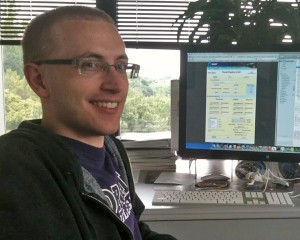McKenna pursues doctorate in data visualization
What happens when galaxies collide? As Sean McKenna ’12 investigated this problem in his astrophysics class, it became clear to him that his interest was not simply in understanding the physics of a process that can take millions of years and spans many thousands of light years, but also in improving computer simulation software to allow others to better see and understand the phenomena.

“When you’re thinking on such a large scale,” he said, “how do you best present the information—in 2D? 3D? I’ve always loved science, and I find it interesting to know about galaxy collisions and lots of other scientific topics. But getting useful information out to people is more interesting to me than the theory–that’s what data visualization is all about.”
McKenna, who majored in computer science and physics, took this passion a step further during a summer internship at the Space Telescope Science Institute (STScI) in Baltimore, immersing himself in the world of citizen science research. His primary task was to build software tools to help citizens around the world identify and record interesting features on tens of thousands of older planetary images from the Hubble Space Telescope. He accomplished this in part by modifying a graphical overlay map that helps users distinguish between expected objects, such as moons, and unexpected objects, such as cosmic rays.
McKenna also created a better interface for research scientists, allowing them to more productively search and filter the information being enhanced by citizens. His work will become part of CosmoQuest’s Planet Investigators project, a new citizen science initiative that expands on similar efforts related to moon and asteroid images.
This experience helped McKenna land a graduate position at the University of Utah’s Scientific Computing and Imaging Institute. There he will pursue a doctorate in computing, specializing in developing tools and methods to visualize complex data sets from a variety of fields, such as biomedicine and geophysics.
“Having the opportunity to work on real scientific research while developing visualizations for clients is what gets me excited about working at SCI,” he said.
At Cornell, McKenna applied his technology and problem solving skills to a range of campus leadership positions. In his three years with the campus radio station (KRNL), including as station manager for a year, McKenna refined Cornell’s web streaming service for the benefit of listeners, while also implementing open source station management software to streamline management of the station’s operations. He brought similar improvements to the Student Senate, greatly improving collaboration and information sharing by using cloud-based computing for document storage.
His favorite aspect of studying at Cornell has been the close relationships formed with professors. In addition to working closely with faculty in small classroom settings, McKenna noted that he interacted with his professors regularly outside the classroom, such as in a physics reading group and in trips to job sites, conferences, and programming competitions with computer science faculty.
“Seeing your professors in these different settings and working directly with them on research, scholarship applications, etc. is very meaningful and something you probably don’t experience as much at larger schools,” he said. “And I’m always impressed that they’re willing to learn more right along with us.”



